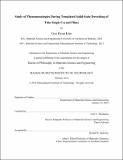| dc.contributor.advisor | Carl V. Thompson. | en_US |
| dc.contributor.author | Kim, Gye Hyun | en_US |
| dc.contributor.other | Massachusetts Institute of Technology. Department of Materials Science and Engineering. | en_US |
| dc.date.accessioned | 2016-06-22T17:19:26Z | |
| dc.date.available | 2016-06-22T17:19:26Z | |
| dc.date.copyright | 2016 | en_US |
| dc.date.issued | 2016 | en_US |
| dc.identifier.uri | http://hdl.handle.net/1721.1/103184 | |
| dc.description | Thesis: Ph. D., Massachusetts Institute of Technology, Department of Materials Science and Engineering, 2016. | en_US |
| dc.description | This electronic version was submitted by the student author. The certified thesis is available in the Institute Archives and Special Collections. | en_US |
| dc.description | Cataloged from student-submitted PDF version of thesis. | en_US |
| dc.description | Includes bibliographical references (pages 188-191). | en_US |
| dc.description.abstract | Generally, thin films are away from equilibrium in the as-deposited state and will agglomerate, or dewet, to form islands given sufficient atomic mobility. This dewetting process can occur in the solid state, well below the films' melting temperature. Dewetting initiates from film-substrate- vapor three-phase boundaries, which can form naturally via natural hole formation in the continuous film or be intentionally made via pre-patterning of the film. These boundaries, or film edges, then retract via capillarity-driven mass transport. As the edges retract, many phenomena occur, making the dewetting morphology complex. Dewetting of thin films has traditionally been considered undesirable in the microelectronics industry, but more recent studies utilized dewetting in many applications, including sensors, solar cells, fuel cells, and catalysts for nanowire and nanotube growth. Solid-state dewetting of single crystal films leads to a very regular morphology, due to anisotropy in surface energy and surface self-diffusivity. When such films are templated by pre patterning, regular dewetting patterns, much smaller than the original templates, can be made. Thus, templated dewetting can be a potential method for generating complex nanostructures with sub-lithographic length scales. However, controlling such dewetting patterns necessitates in depth quantitative understanding of anisotropic solid-state dewetting. The research described in this thesis focused on detailed analysis of individual dewetting phenomenologies, using single crystal Ni films as a model system. The rate of capillarity-driven edge retraction was found to depend strongly on the in-plane orientation of the edge and the ambient condition. It was determined that the surface structure of the top facet under different ambient conditions are closely linked to the differences in the edge retraction rates. As the edge retracts, a thickening rim forms due to mass accumulation at the edge. Also, a valley can form ahead of the rim under certain conditions, and this valley can pinch off the rim, resulting in wireline structures. This pinch-off phenomenon was also found to be strongly dependent on the inplane orientation of the retracting edge. It was determined that pinch-off occurs more easily when the additional surface energy cost associated with initiation of valley formation is smaller. The retracting rim itself can also become unstable and can form finger-like structures similar to the cellular structures that often form during solidification. It was found that mass is rejected from the finger tip, so that the rim at the tip maintains a constant height and the fingered front moves at a constant rate. A steady-state model for the motion of a fingered front was developed and found to be in agreement with experiments. This model accounts for the lateral rejection of mass to form wire-like structures between the fingers, and shows that the finger spacing is determined by the velocity of the finger tips relative to the diffusivity governing mass rejection. Both pinch-off and the fingering instability result in wire-like structures, and these structures can undergo a Rayleigh-like instability in later stages, in which they break up into smaller particles. The characteristic spacing of the de wetted particles was also found to be strongly dependent on the in-plane crystallographic orientation of the wire-like structures. It was further found that for a fixed cross-sectional area, the total surface energy of the wire-like structure determines the particle spacing. Lastly, it was found that while natural holes that form in single crystal films initially have polygonal shapes, as their growth slows, corners often begin to retract faster than the straight edges, in a way similar to the fingers on a fingered front. A computational model was developed for such a corner instability, and the balance between the thinning of the corner tip due to tip lengthening and the thickening of the tip due to mass accumulation during retraction was found to determine the condition under which the corner retracts at a constant rate. | en_US |
| dc.description.statementofresponsibility | by Gye Hyun Kim. | en_US |
| dc.format.extent | 191 pages | en_US |
| dc.language.iso | eng | en_US |
| dc.publisher | Massachusetts Institute of Technology | en_US |
| dc.rights | M.I.T. theses are protected by copyright. They may be viewed from this source for any purpose, but reproduction or distribution in any format is prohibited without written permission. See provided URL for inquiries about permission. | en_US |
| dc.rights.uri | http://dspace.mit.edu/handle/1721.1/7582 | en_US |
| dc.subject | Materials Science and Engineering. | en_US |
| dc.title | Study of phenomenologies during templated solid-state dewetting of thin single crystal films | en_US |
| dc.type | Thesis | en_US |
| dc.description.degree | Ph. D. | en_US |
| dc.contributor.department | Massachusetts Institute of Technology. Department of Materials Science and Engineering | |
| dc.identifier.oclc | 951807119 | en_US |
